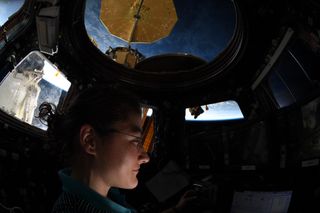NASA astronaut Christina Koch celebrates her 300th day in space
NASA astronaut Christina Koch has smashed another gender barrier. Koch recently surpassed her 300th consecutive day in space, which is the longest for any woman — and she's still got several weeks of orbital work to go.
This milestone represents only some of the notable recent work for the 40-year-old astronaut, who is still on her first spaceflight. In October, Koch and fellow American Jessica Meir completed the first all-woman spacewalk — and the pair may finish at least three excursions together before the mission is finished. They completed a second spacewalk together on Jan. 15 and have one more scheduled for Jan. 20.
Koch, who launched to the International Space Station (ISS) on March 14, 2019, is expected to spend a total of 328 days in space before returning to Earth on Feb. 6. During her extended stay at the orbiting laboratory, she served as a flight engineer on Expeditions 59, 60 and 61 and has completed five spacewalks.
Video: 300 Days in space for NASA astronaut Christina Koch
Related: Christina Koch breaks record for longest space mission by a woman
For 300 days I’ve been fortunate to be a part of something that strives to represent and benefit all humanity. As I look out and reflect on our shared world, that has been the greatest honor. pic.twitter.com/uQuS5F4rXjJanuary 9, 2020
"For 300 days, I've been fortunate to be a part of something that strives to represent and benefit all humanity," Koch wrote on Twitter Jan. 9, when she passed the 300-day mark. She posted a view of Earth from the International Space Station. "As I look out and reflect on our shared world," she added, "that has been the greatest honor."
Two women actors from "Star Wars: The Rise of Skywalker" recently visited NASA's Johnson Space Center in Houston to talk about Koch's milestone in a video posted late December to the ISS Twitter feed.
"We hear you are breaking the record of the longest duration of spaceflight," said Naomi Ackie, who played Jannah. "By a woman!" added Kelly Marie Tran (who played Rose Tico). The women did simultaneous fist-pumps of celebration. "Yes!" they shouted.
Get the Space.com Newsletter
Breaking space news, the latest updates on rocket launches, skywatching events and more!
Ackie and Tran said they were inspired not only by the science work that Koch is doing but also by her contributions to women and to the world. "We want to be you!" Tran added.
Most missions to the ISS last five or six months, but that's something NASA and the international partners want to change. The agency plans to land people on the moon in 2024 in preparation for a trip to Mars in the mid-2030s. Since the fastest way to get to Mars takes about nine months, NASA wants to add longer spaceflights to the ISS manifest to learn how the human body changes in microgravity.

"Extended missions like Christina's will help scientists gather data about the effects of long-duration human spaceflight," NASA administrator Jim Bridenstine said in a tweet Jan. 9. Doctors are interested in matters such as bone mass, muscle strength and eye pressure, all of which worsen among people who spend a long time in space. More human subjects in space would allow doctors to potentially try new countermeasures to stop or slow the progression of these problems.
Koch's milestone places her among a group of astronauts who have made notable ISS stays. In 2015-2016, NASA astronaut Scott Kelly and Russian cosmonaut Mikhail Kornienko spent 340 consecutive days on the ISS, smashing the previous record for that facility. And NASA astronaut Peggy Whitson had a 288-day stay between 2016 and 2017. But only a handful of folks have persisted beyond 200 days in a single space mission, and most of them were male Russian cosmonauts on the space station Mir in the 1990s. (Incidentally, the longest spaceflight ever was that of Valery Polyakov, who did a 438-day marathon on Mir in 1994-1995.)

Koch — who will also celebrate her 41st birthday in space later this month — is expected to return to Earth this spring, along with two of her Expedition 61 crewmembers, European Space Agency astronaut Luca Parmitano and Russian cosmonaut Alexander Skvortsov.
- Women in space: a gallery of firsts
- NASA astronauts recount epic all-woman spacewalk in Washington Post op-ed
- NASA astronaut celebrates Women's Equality Day in space at midpoint of record-breaking flight
Follow Elizabeth Howell on Twitter @howellspace. Follow us on Twitter @Spacedotcom and on Facebook.

Join our Space Forums to keep talking space on the latest missions, night sky and more! And if you have a news tip, correction or comment, let us know at: community@space.com.

Elizabeth Howell (she/her), Ph.D., is a staff writer in the spaceflight channel since 2022 covering diversity, education and gaming as well. She was contributing writer for Space.com for 10 years before joining full-time. Elizabeth's reporting includes multiple exclusives with the White House and Office of the Vice-President of the United States, an exclusive conversation with aspiring space tourist (and NSYNC bassist) Lance Bass, speaking several times with the International Space Station, witnessing five human spaceflight launches on two continents, flying parabolic, working inside a spacesuit, and participating in a simulated Mars mission. Her latest book, "Why Am I Taller?", is co-written with astronaut Dave Williams. Elizabeth holds a Ph.D. and M.Sc. in Space Studies from the University of North Dakota, a Bachelor of Journalism from Canada's Carleton University and a Bachelor of History from Canada's Athabasca University. Elizabeth is also a post-secondary instructor in communications and science at several institutions since 2015; her experience includes developing and teaching an astronomy course at Canada's Algonquin College (with Indigenous content as well) to more than 1,000 students since 2020. Elizabeth first got interested in space after watching the movie Apollo 13 in 1996, and still wants to be an astronaut someday. Mastodon: https://qoto.org/@howellspace
